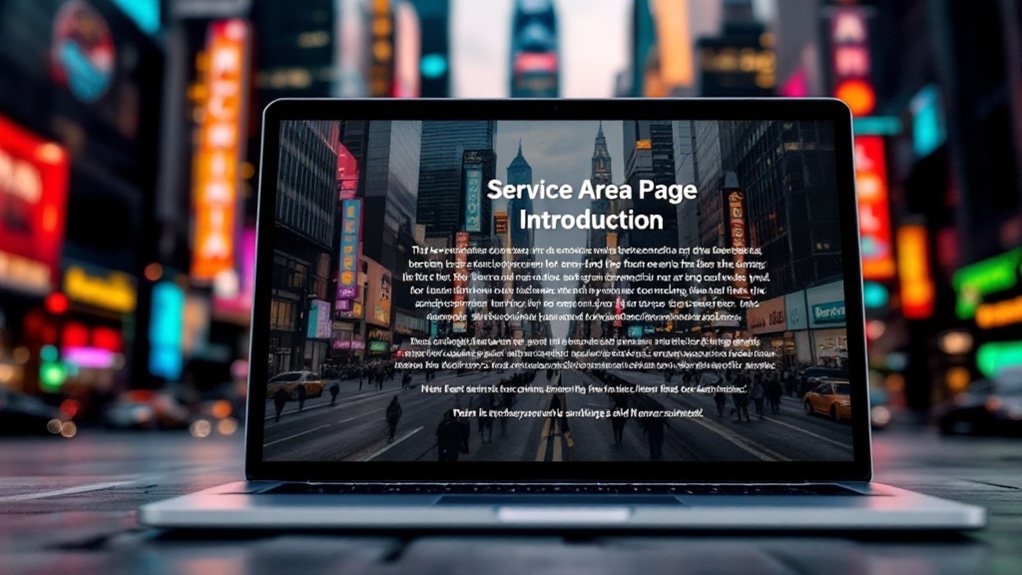To craft a compelling city-specific service area page intro, start by highlighting your local relevance. Mention prominent landmarks and emphasize your company's community involvement to build trust. Define your targeted service area, then emphasize your unique selling points like specialized expertise and exclusive offerings. Address common customer needs with reliable, high-quality solutions. Optimize for local search intent, and ensure accurate contact details. By leveraging this strategic approach, you'll captivate your local audience and encourage them to learn more.
Crafting a Compelling Overview

When crafting a compelling overview for your city-specific service area pages, you'll want to focus on engaging your readers from the very start. Use strong headlines and subheadings to draw attention and clarify the main topic. Define the purpose and focus of the content early on, and organize it using headings, lists, and concise paragraphs for ease of navigation. Ensure the narrative voice and structure align with your brand's identity and messaging, facilitating a smooth flow from introduction to conclusion. Incorporate relevant data, such as statistics and case studies, to add credibility and depth to your overview. By following these strategies, you'll create an engaging and informative introduction that showcases your local services effectively.
Highlighting Local Relevance

Highlighting the local relevance of your city-specific service area pages is crucial in capturing the attention of your audience. Mention prominent local landmarks, community events, and demographic details to create a strong connection. Emphasize your company's local affiliations and employee involvement to build trust. Utilize local service ads effectively to position your business for maximum visibility in the target areas. Craft hyperlocal blog posts, tailor area-specific pages, and encourage local reviews to demonstrate your deep understanding of the community. Optimize your content for local SEO by researching relevant keywords, internal linking, and using geographic terms. Establish community ties by creating local guides, educational content, and highlighting your charity involvement. Continuously measure your success through content analytics, review response strategies, and feedback loops to refine your localized approach.
Defining the Targeted Service Area

Defining the precise geographic boundaries of your targeted service area is crucial for optimizing your online presence and effectively reaching your desired customer base. Consider factors like your business infrastructure, customer demographics, and the competitive landscape to determine the appropriate scope. Analyze market demand, identify underserved areas, and assess operational efficiency to refine your service area. This will enable you to tailor your offerings and craft compelling service area pages that resonate with local audiences. By clearly delineating your service area, you can enhance your search engine visibility, build trust, and ensure seamless delivery of your products or services across the designated region. Determining the optimal service area that balances demand and operational capacity is also important for your business.
Emphasizing Unique Selling Points
Emphasizing your city-specific unique selling points is crucial for differentiating your business and appealing to local audiences. Highlight your partnerships, expertise in local conditions, and city-specific content. Showcase your competitive advantages, such as exclusive services, faster response times, or specialized certifications. Leverage your employees' local knowledge, successful project histories, and customer satisfaction ratings. Outline the unique benefits of choosing your business, like tailored services, community involvement, and exclusive promotions. Support your claims with city-specific data on performance, cost savings, and innovative solutions. Demonstrating your deep understanding of the local market will position you as the go-to provider in the city.
Addressing Common Customer Needs
When crafting your city-specific service area page introductions, it's crucial to address the common needs and expectations of your local customers. Focus on offering friendly, empathetic interactions that demonstrate your understanding of their circumstances. Ensure your products and services meet their specific needs with high quality and convenience. Provide efficient, timely solutions and 24/7 support to cater to time-sensitive demands. Emphasize the reliability, value, and proactive problem-solving that build trust and loyalty. Offer a range of options to satisfy customer preferences to make your services accessible across multiple channels, tailoring communications to personalize the experience. By addressing these common needs, you'll create introductions that resonate with your target audience and showcase your commitment to exceptional customer service.
Incorporating Authentic Testimonials
Building upon the insights from addressing common customer needs, incorporating authentic testimonials is a powerful way to showcase your local expertise and reliable service. Leverage varied formats, including text, video, and short quotes, to cater to diverse preferences. Highlight customer satisfaction by emphasizing positive outcomes and resolved issues. Feature real voices and opinions to build trust and credibility. Include case studies that showcase successful local projects and experiences. Ensure the testimonials are genuine and verified to avoid skepticism. Strategically place testimonials on your service area pages to enhance visibility, credibility, and customer experience. Utilize interactive elements, infographics, and short quotes to present the testimonials in a visually engaging manner. Additionally, tailoring the testimonials to specific geographical locations can further enhance the relevance and impact for local customers.
Optimizing for Local Search Intent
When optimizing for local search intent, you'll want to ensure your city-specific service area pages are highly relevant and geographically targeted. Local search intent is a powerful driver of business success, particularly for companies relying on attracting customers from specific geographic areas. Leveraging local keywords, tailored content, and authentic reviews can help boost your visibility among nearby customers. By focusing on geographic relevance, you can better connect with your local audience and drive valuable leads.
Local Search Optimization
As a business owner, optimizing your website for local search intent is crucial for attracting nearby customers. Local search strategies utilize search engine optimization (SEO) to help businesses rank higher, get found, and attract more website visitors. Focus on incorporating relevant local keywords and landmarks into your content to improve visibility in hyper-local searches. Utilize tools like Google Keyword Planner to identify the most valuable local terms, and ensure your Google Business Profile is fully optimized. Craft service pages tailored to each city you serve, embedding local keywords and testimonials. Regularly update your content to maintain relevance and boost your SEO rankings. By understanding your local audience's search habits and intent, you can create a strong online presence and connect with your community.
Geographic Relevance
Establishing geographic relevance is paramount when optimizing for local search intent. Incorporating explicit location terms, like "San Diego electrician," signals to search engines that your content is tailored to a specific area. Implicit signals, such as a user's IP address or GPS data, can also trigger "near me" searches. Ensure your content reflects the proximity expectations of your industry—customers may expect quick access to casual services but be willing to travel further for specialized ones. Leverage hyper-local keywords, referencing neighborhood names and landmarks, to enhance your content's relevance. By aligning your pages with the geographic context of your target audience, you'll improve your visibility in local search results.
Ensuring Accurate Contact Information
Accurate contact details are crucial for establishing credibility and trust with potential customers. Be sure to prominently display your business name, address, and phone number on each service area page to ensure consistency across your web platforms. Keeping your location information up-to-date helps you connect with local searchers and maintain a strong online presence. This is necessary for businesses without physical locations to rank for local terms.
Accurate Contact Details
Ensuring accurate contact details is paramount, as it directly impacts your ability to build trust with clients through seamless communication. Correct phone numbers and addresses prevent missed calls and misdelivered documents, improving operational efficiency and enabling timely customer support. Maintaining up-to-date data is crucial for making informed decisions, minimizing errors, and reflecting a professional brand image. Accurate contact information ensures successful supply chain coordination, effective marketing, and compliance with regulations. Regularly updating databases, verifying data, and utilizing automation and technology are key strategies to maintain data integrity. Inaccurate details can frustrate customers, damage your reputation, and result in wasted resources and poor decision-making.
Prominently Display Location
Displaying your location prominently on your service area pages is key. Include a detailed map of your service area to provide clear geographical context. Leverage city-specific keywords to optimize your local SEO and make it easier for customers to find you. Mention nearby landmarks or neighborhoods to connect with your local audience. Embed images specific to the location to increase engagement. Optimize your page URLs with the city name to enhance discoverability. By highlighting your geographic relevance, you'll build trust and credibility with your target customers.
Leveraging Visual Elements Effectively
Visuals can powerfully complement the information on your service area page, captivating users and solidifying your local presence. Interactive maps highlight your coverage, while photos of landmarks forge community connections. Profiles, service area imagery, and customer testimonials build credibility. Consistent color schemes and eye-catching callouts reinforce your brand and engage users. Animations, responsive design, and multimedia like videos and 360-degree views enhance the experience. Strategically place hero images, organize content in sections, and leverage local references. A/B testing, user feedback, and metrics can all optimize your visual effectiveness, boosting conversions and SEO.
Crafting a Persuasive Call to Action
Your call-to-action (CTA) is the cornerstone of engagement. Leverage direct, action-oriented phrases like "Shop Now" to drive clicks. Pique curiosity with "Learn More," or create a sense of urgency with "Limited Time Offer." Appeal to users' need to belong with exclusive offers. Prompt immediate action with "Download Now" or "Sign Up." Incorporate action verbs, incentives, and psychological triggers to boost conversions. Position CTAs prominently and tailor them to your audience. Contrast colors to make them stand out, and use clear, direct language. Analyze your audience's needs and align CTAs with your campaign's purpose. Prioritize clarity, conciseness, and specificity for effective communication.
